Montepulciano's tourism boom and the 500th anniversary of the temple of San Biagio. An interview with Riccardo Pizzinelli
TheValdichiana, and in particular the Montepulciano area, has experienced a real boom in tourist presences inrecent years. According to the Florence-based Center for Tourism Studies, which processed data provided by the Region of Tuscany and the Tourism Office of the Municipality of Siena, there were 500,000 arrivals and just under 1,300,000 presences in the area in 2017, up 4.5 percent (double the regional average) and 2.5 percent, respectively. Most tourists arrive to visit the beauty of Montepulciano. Just this year the city is celebrating the 500th anniversary of the start of construction of the temple of San Biagio, one of the greatest masterpieces of Renaissance architecture in all of Italy, the construction of which began in September 1518, based on a design by Antonio da Sangallo the Elder (Florence, 1455 - 1534). How is the city preparing for the event? How does it plan to handle the increasing tourist flows? What is the profile of tourists visiting the city, and why are they attracted to it? How, on the other hand, do citizens experience the city and the 500th anniversary of the temple? We talked about all these topics with architect Riccardo Pizzinelli, president of the Opere Ecclesiastiche Riunite di Montepulciano, the entity, founded in 1923, that administers the city’s monumental buildings of worship. The interview is by Federico Giannini, editor in chief of Finestre sull’Arte.
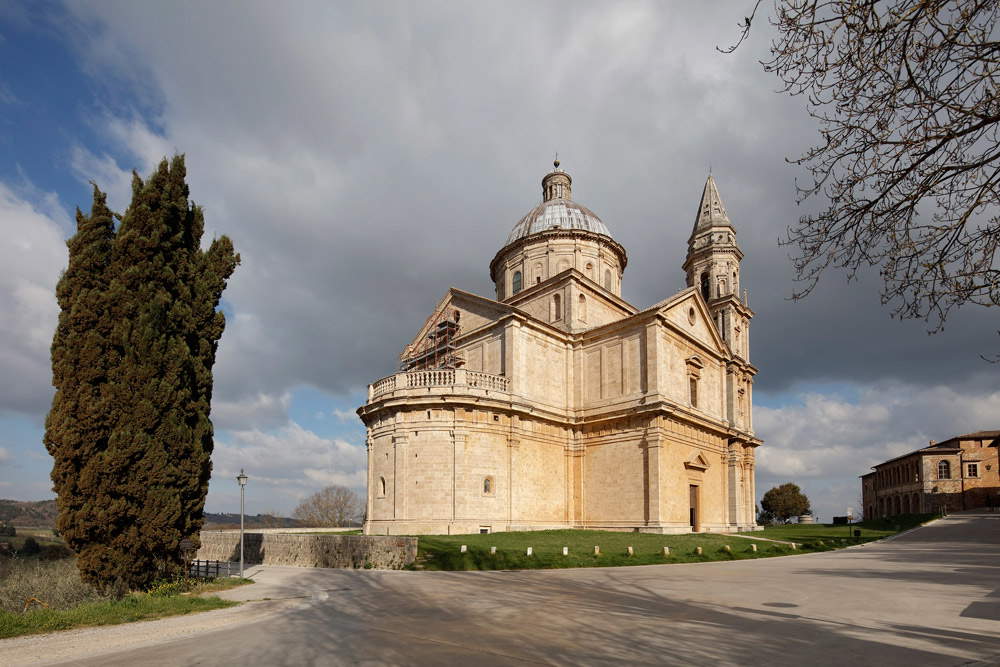 |
| The temple of San Biagio in Montepulciano. Courtesy Opere Ecclesiastiche Riunite |
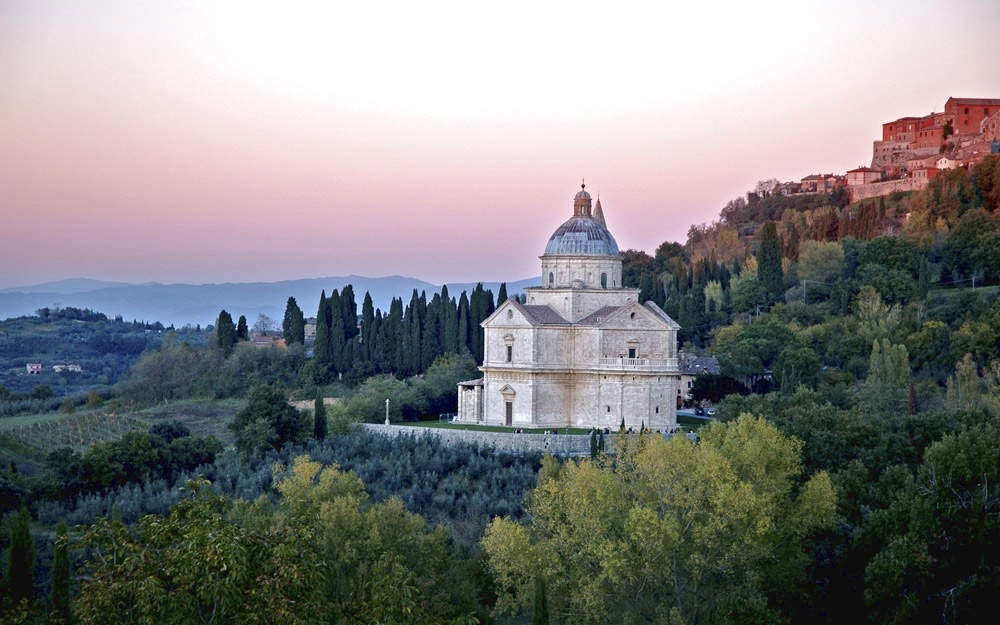 |
| The temple of San Biagio in Montepulciano in the landscape, in the background the city. Courtesy Opere Ecclesiastiche Riunite |
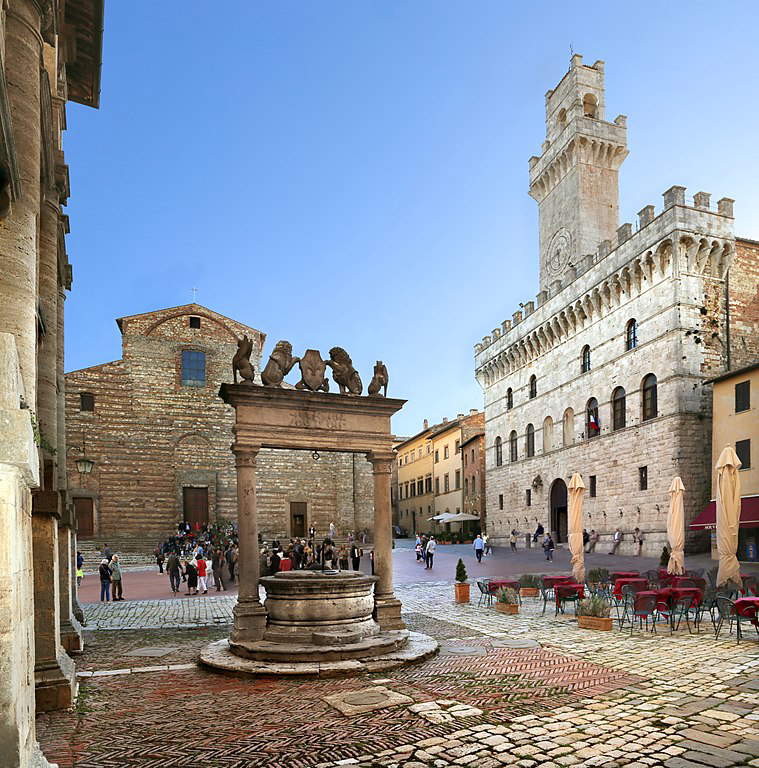 |
| The Piazza Grande in Montepulciano. Ph. Credit Francesco Bini |
FG. Architect Pizzinelli, the five-hundredth anniversary of the church of San Biagio got off to a good start in the name of making it more welcoming to visitors, and safer. What has been done in this regard?
RP. As far as security is concerned, the celebration is part of a path that the Opere Ecclesiastiche Riunite of Montepulciano has taken in recent years to counter some phenomena (for example, some thefts) that have occurred because the monument has a rather isolated location with respect to the urban context and therefore is sometimes exposed to certain risks: we have therefore come to have a constant custody that verifies everything that happens inside the temple. In addition to the security measures, in order to be able to maintain and enhance the possibility of visiting the monument, a program has been added that has Civita-Opera Laboratori Fiorentini as a partner and that has set itself the goal of allowing the enhancement of the property through the presence of qualified personnel, a bookshop, historical-artistic information, a new guide, an audio guide and an app for smartphones that gives news to visitors.
About the audio guide: this tool, in addition to giving information about the temple, also invites the visitor to discover the cultural heritage of the city: the Opere Ecclesiastiche Riunite of the rest have made no secret of the fact that the hope is for a more conscious enjoyment...
In the meantime, it must be said that we were facilitated by the fact that San Biagio is a masterpiece of the Renaissance. After all, it is clear that one of the pearls of Montepulciano is precisely the temple of San Biagio, and the image of the temple has been superimposed on the image of Montepulciano in the world because the temple is indeed very well known not only by architectural historians but also by the general population. But the whole of Montepulciano, at least from the 1620s until the middle of the century, had an explosion of interest in art and architecture that brought this small town into contact with Roman and Florentine culture, the two poles to which both the noble families of Montepulciano of the time and the important figures who were present in the town at the time referred (among them, for example, Pope Marcellus II, whose family came from Montepulciano). In this sense, in fact, the San Biagio constitutes a kind of completion (since it is one of the most important monuments in the city), but also a beginning of a visit that actually concerns all the Renaissance places in Montepulciano, also in reference to the architect who built the temple of San Biagio, Antonio da Sangallo the Elder, who worked a lot in the city and to whom several architectures, including civil ones, of Montepulciano have been attributed in the past, for which the city is famous. The one put in place with Civita-Opera Laboratori Fiorentini, which has supported us on this path, is a synergy that works.
From many quarters, after all, it is noted how tourists literally love Montepulciano. But who is typically the traveler who visits Montepulciano?
There are different types of presence. The most conspicuous one is an international presence: in the past, tourism in Montepulciano was mostly European, but now it is expanding. For example, there is a strong American presence, which moreover is not only touristic, but is also institutional: recently Kennesaw University in Atlanta opened a summer branch in Montepulciano, something that European institutions had also done in the past. Then, in recent years, because of the changes that tourist flows have had as a result of the well-known episodes of international terrorism, there has also been a considerable increase in Italian clientele, and this is not only in the summer period, which is the one that brings the greatest presence of foreign clientele, but also in the rest of the year: at this time the presences are therefore divided between this flow of Italians who stay for short periods, of two or three days, and the international clientele who, taking advantage above all of the agritourisms, stay in the area even five, six or seven nights.
She also referred to collaborations with American universities. The five-hundredth anniversary of San Biagio will also be under the banner of international cooperation: a collaboration with Harvard University has been activated in this regard. However, that between Harvard and Montepulciano is a relationship that goes back to 2014, when the renovated courtyard of the Fogg Art Museum, designed by Renzo Piano, was inaugurated. How has the relationship with the prestigious U.S. university continued, what is on the agenda this year and how will the collaboration continue in the future?
Actually, the link between Harvard and Montepulciano has more remote origins, dating back as far as the 1920s, when the American university sent some architects to Italy to survey monuments on the basis of which to reconstruct the Fogg Art Museum’s headquarters in Harvard. Initially, it was planned to survey courtyards of Renaissance Rome: then, for various reasons, the architects came to Montepulciano and studied the facade of the rectory of San Biagio, which is part of the monumental complex. When they arrived in America, the Harvard architects reconstructed the facade on four sides, making it into a courtyard, which, moreover, was very important, but we Italians had lost track of it (and perhaps we did not even know this history well), and the Americans themselves had somewhat lost memory of this fact. When the renovation project of the museum building was approved at Harvard in the 2000s, parts of the old building were demolished, but the courtyard was retained and covered with a large glass dome, according to Renzo Piano’s design. So, as part of this renovation, Harvard University went in search of the reasons why the courtyard was built in this way, with the result that its history was rediscovered: therefore, they themselves approached us, since 2014 there have been some meetings, and just on the occasion of the five-hundredth anniversary, we have been trying to forge these relationships. At Harvard, in the courtyard, there will be initiatives starting right from April 2018, initiatives that will end in the summer period. Then there will be a presence of the Harvard delegation in our Five Hundredth Anniversary celebrations. The crucial date is September 15, 1518, the day on which the foundation stone of the temple of St. Blaise was laid: a delegation from Harvard University will be present here, and they will present the book on the courtyard of the restoration of the museum. Afterwards, we will conclude our year of celebration by going to Harvard. So a synergy is being created, a contact, a concrete relationship on something that is not only symbolic but real, a relationship in which the administration is also believing a lot, and I believe there will be further developments. Already this year some students will come to have an experience here in Montepulciano, and there will be Italian art history students who will go to Harvard to have a twin experience.
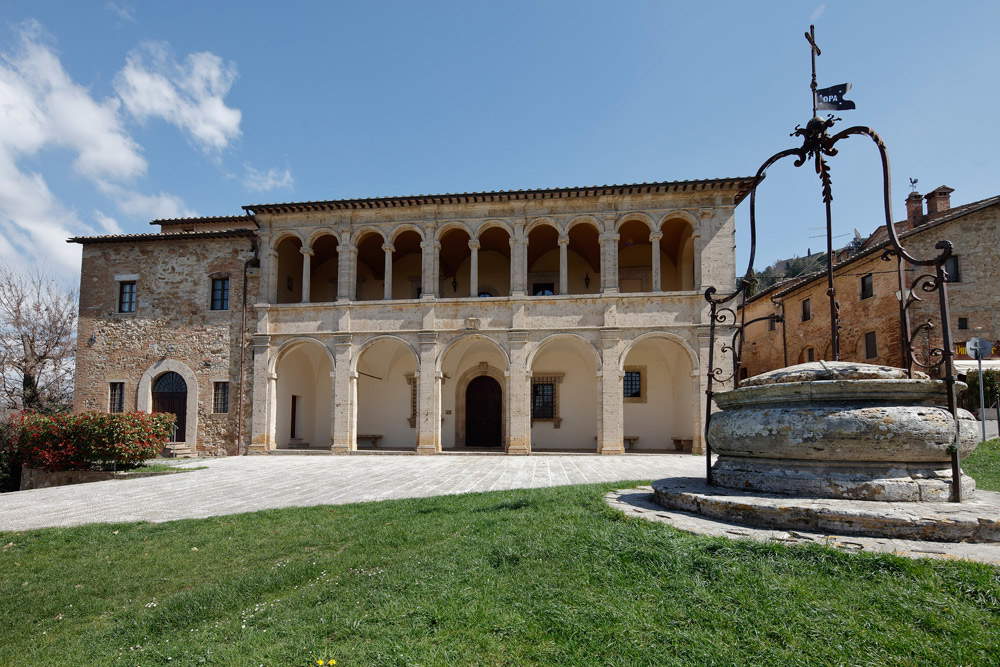 |
| The facade of the rectory of San Biagio. Courtesy Opere Ecclesiastiche Riunite |
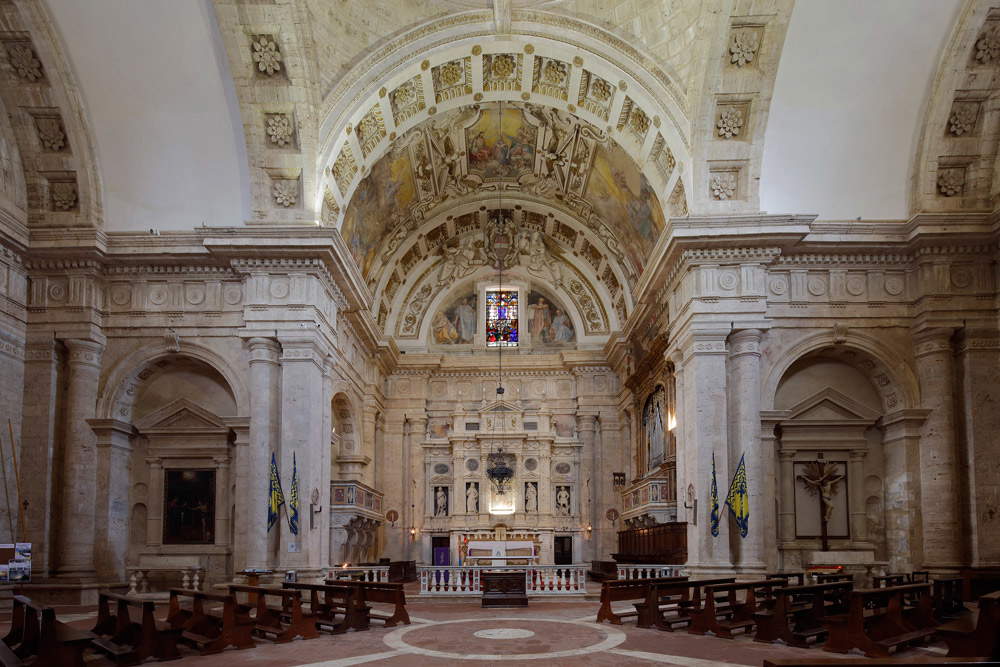 |
| Interior of the temple of St. Blaise. Courtesy Opere Ecclesiastiche Riunite |
The Temple of San Biagio has often been the scene of film shoots that have somehow made it the protagonist of films shot all over the world: what feedback has this attention of cinema to the church and Montepulciano been able to guarantee, in terms of tourist attendance or interest in the city?
Especially in recent years and with the spread, through social media, of a whole series of images, the feedback has been very relevant. Part of this has happened because some of these productions were aimed at a relatively young user population (think of the fans of the movie Twilight), who were then prompted to visit the places where their favorite scenes were filmed. In fact, already since the 1950s, with Malaparte’s The Forbidden Christ, Montepulciano has been the site of film sets: more recently, the fiction about the Medici was filmed in the town, with some scenes also filmed in San Biagio (in this case, however, in disguise: the setting was in fact meant to recreate 15th-century Florence). This fact certainly brought an important increase. Let’s say, however, that from a qualitative point of view there is a strong presence of the one-day trip: tourists come to visit the places of the film set, then those who remain more sensitized stay maybe two or three nights, but in the case of tourists driven by the cinema it is mainly a “hit-and-run” tourism that perhaps in perspective is not the best, but certainly the spread of the name and image has been relevant because tourist flows have increased even in these very recent years.
And have you already thought about, or are you already putting in place, any measures to counter the “hit-and-run” tourism that you just mentioned?br /> These mechanisms are not so simple. I think Montepulciano is at a crossroads, because it has to decide whether to remain a town of simple “consumption” of culture, or whether to structure itself into a reality that offers even more than just visiting.This great tourist boom must be consolidated at the level of supply, in the sense that entrepreneurs need to invest in quality, and the administration needs to build infrastructure. If a qualification of services and offerings will take place, I believe Montepulciano can make a qualitative leap in terms of tourist loyalty as well. In order to avoid the “hit-and-run” we need to captivate, to try to ensure that an interest can be maintained for longer periods of time, and Montepulciano from this point of view would also have the cards in order, because it is already home to various initiatives, from the Cantiere internazionale d’arte, to the Bravìo delle Botti, to the Poliziano Bruscello and other events that make a visit interesting not only from a historical and cultural point of view but also from an anthropological, theatrical or gastronomic point of view, making the tourist tend to stay. I believe that if a synergy between the various stakeholders continues, we can have a much more lasting development.
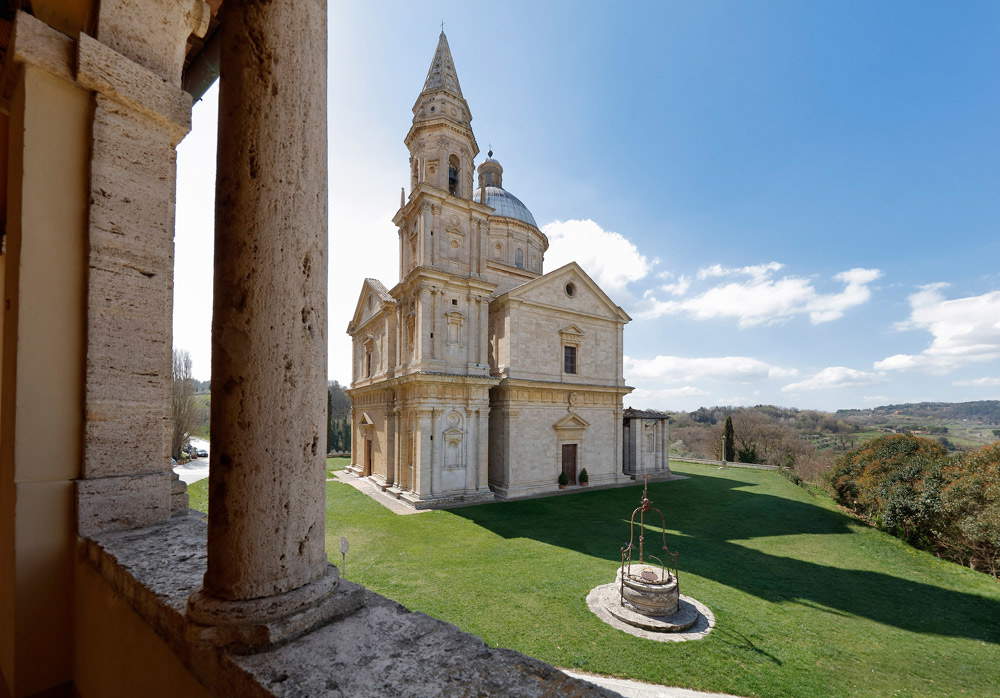 |
| View of the temple of St. Blaise from the rectory. Courtesy Opere Ecclesiastiche Riunite |
Changing the point of view instead, how is the citizens of Montepulciano experiencing their relationship with their city, with the church, with tourism, and of course with the five-hundredth anniversary?
From this point of view, the five-hundredth anniversary represents a bet, also because our institution is ... a poor institution: we do not have great resources. So we have tried to broaden the scope of the celebration by involving all stakeholders in the area, asking for a gift for our five-hundredth anniversary. So there are those who support us financially, such as the administration and the diocese, and those who, on the other hand, such as private individuals and companies, support us by guaranteeing performances, concerts, exhibitions, conferences: all the important entities in the city have offered us something. The reasoning behind this is quickly stated: Saint Blaise is everyone’s property. Of course, all our assets belong to everyone, but San Biagio all the more so, because it was not built by the Church but by the municipality, and those who managed the funds even in ancient times were precisely the municipality. Unfortunately, over time this concept, as very often happens in Italy, has been lost, so that we have reached a point where not everyone feels the temple as their own. The five-hundredth anniversary should serve precisely to remind everyone, starting with school children and young people, that this is everybody’s property, and all together we have to protect it, we have to enjoy it, we have to respect it, we have to make sure that future generations receive it at least in the condition in which we had it. And five hundred years is a good time frame to do such a work.
In the meantime, the program of celebrations continues: what is next on the agenda?
April 23, 1518 is the five-hundredth anniversary of the miracle that is the basis for the construction of the temple, so we planned to carry out a series of initiatives around this date. In particular, on Saturday, April 21, there will be the inauguration of an exhibition inside the temple of San Biagio, entitled The Temple of San Biagio after Antonio da Sangallo, which traces the story of the historical and artistic furnishings of the temple’s interior, made not in the Renaissance, but between the late sixteenth and mid-seventeenth centuries, with a series of interventions that made the interior much more baroque than we know it. In the nineteenth century there was in fact a neo-Renaissance restoration of the interior, and during this intervention much of the historic furnishings and paintings that had been made in the sixteenth and seventeenth centuries were removed. Our project, which has already been carried out, is to bring these large canvases back inside the temple and to reconstruct the entire history of the 16th- and 17th-century furnishings and neo-Renaissance restoration. It will be possible to visit the exhibition throughout the summer, since it runs from April 21 until Nov. 4. Also on April 21 will be followed by an organ concert by maestro Cesare Mancini, partly because among the various initiatives was the restoration of the temple’s exceptionally valuable historic organ. On Sunday, 22, there will instead be a celebratory lecture entitled The Years of the Temple of St. Blaise. From the Modern Manner to the Counter-Reformation, given by Professor Antonio Natali, former director of the Uffizi. This will be followed by an additional concert by the Cantiere Foundation. Beyond this weekend, however, there will be a number of events, especially in June and July, perhaps the richest period: on June 15 in San Biagio there will also be an assembly of the fabbricerie d’Italia, and there will be important conferences especially in July, the month during which the temple will become the venue for the Cantiere Internazionale d’Arte concerts. From early to mid-September, on the other hand, the initiatives will all be aimed at commemorating the laying of the foundation stone, which took place, as we remembered, on September 15, 1518.
Warning: the translation into English of the original Italian article was created using automatic tools. We undertake to review all articles, but we do not guarantee the total absence of inaccuracies in the translation due to the program. You can find the original by clicking on the ITA button. If you find any mistake,please contact us.





























